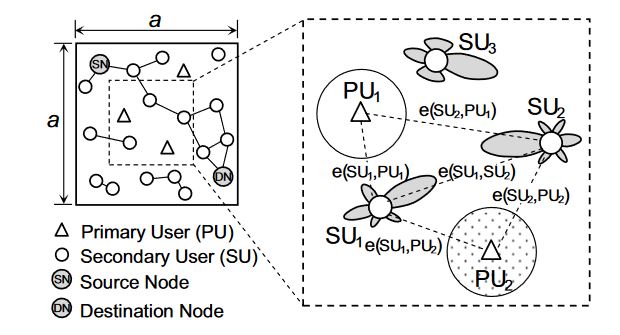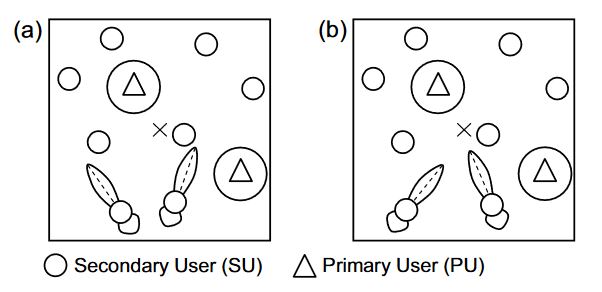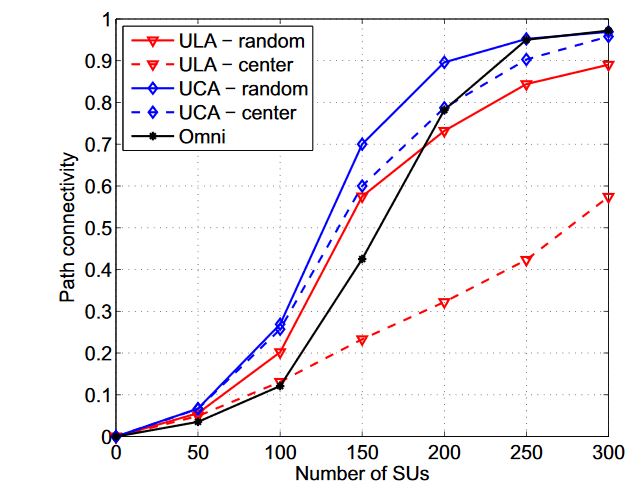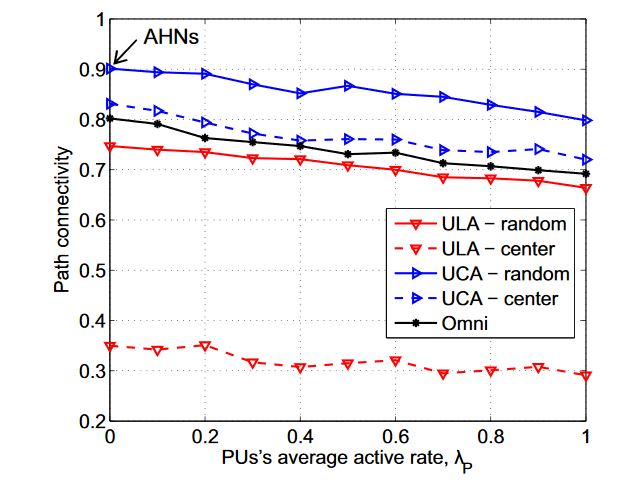ABSTRACT
This paper investigates the impact of using directional antennas and beamforming schemes on the connectivity of cognitive radio ad hoc networks (CRAHNs). Specifically, considering that secondary users use two kinds of directional antennas, i.e., uniform linear array (ULA) and uniform circular array (UCA) antennas, and two different beamforming schemes, i.e., randomized beamforming and center-directed to communicate with each other, we study the connectivity of all combination pairs of directional antennas and beamforming schemes and compare their performances to those of omnidirectional antennas.
The results obtained in this paper show that, compared with omnidirectional transmission, beamforming transmission only benefits the connectivity when the density of secondary user is moderate. Moreover, the combination of UCA and randomized beamforming scheme gives the highest path connectivity in all evaluating scenarios. Finally, the number of antenna elements and degree of path loss greatly affect path connectivity in CRAHNs.
SYSTEM MODEL

Figure 4. The network model of CRAHNs where SUs employ directional antennas and PUs use omnidirectional antennas
In this paper, we assume that PUs use omnidirectional antennas while SUs are equipped with one of two kinds of directional antennas, i.e., uniform linear array (ULA) and uniform circular array antennas as in Figure 4. These directional antennas were widely used in evaluating the connectivity of conventional ad hoc networks with beamforming.
THE IMPACT OF BEAMFORMING ON THE CONNECTIVITY OF COGNITIVE RADIO AD HOC NETWORKS

Figure 5. Illustration of two beamforming schemes used to evaluate the connectivity of CRAHNs: (a) randomized beamforming; (b) center-directed beamforming
Figure 5 illustrates the two beamforming schemes, i.e., randomized beamforming and center- directed beamforming, used to examine the communication possibilities among SUs in CRAHNs. The features of these schemes are briefly described as follows.
EXPERIMENTAL RESULTS AND DISCUSSIONS

Figure 6. Path connectivity corresponding to different kinds of antennas and beamforming schemes
Figure 6 shows path connectivity versus SU density with different combinations of antenna types and beamforming schemes compared with omnidirectional antennas. We can see that, for a low number of SUs, i.e., NS ≤ 50, the path connectivity is low, and there is no significant difference between the two directional antenna types and omnidirectional antennas because the node density is not high enough to ensure that an SU can always find at least one neighboring SU to communicate with, regardless of antenna types and beamforming schemes.

Figure 8. Path connectivity corresponding to different kinds of antennas and beamforming schemes
As shown in Figure 8, similar to the impact of PU density, increase in the average active rate of PU also reduces the available network area for routing among SUs, and, thus, results in the decrease in successful path establishment probability. Particularly, in this evaluating scenario, when λP rises from 0 to 1, path connectivity corresponding to UCA-random, UCA-center, ULA-random, ULA-center, and Omni reduces from 0.91, 0.83, 0.75, 0.35, and 0.81 to 0.79, 0.72, 0.66, 0.29, and 0.68, respectively.
CONCLUSIONS
We have studied the effects of different combinations of directional antennas and beamforming schemes on the path connectivity between two arbitrary SUs in CRAHNs. Particularly, two directional antennas, i.e., ULA and UCA, and two beamforming schemes, i.e., randomized beamforming and center-directed beamforming, are employed. The results on path connectivity of beamforming scenarios are compared with those of omnidirectional antenna to evaluate in what conditions beamforming increases or decreases path connectivity between two arbitrary SUs in CRAHNs.
We discover some important and interesting features which can be summarized as follows. First, using beamforming transmission for SUs only shows noticeable benefits in terms of path connectivity of a secondary network when SU density is moderate. Second, the combination of UCA antenna and randomized beamforming provides the highest connectivity compared with others. Third, the number of antenna elements and degree of path loss greatly influence the path connectivity.
The results in this paper give insights on how beamforming affects path connectivity in CRAHNs. An important feature is that using any kind of directional antennas does not always provide higher path connectivity compared with ominidirectional antennas. Thus, this paper can help network designers select proper directional antenna configuration and beamforming schemes to achieve the highest path connectivity in CRAHNs. Carrying out our real experiments to measure the path connectivity and comparing the measured results with the simulation results obtained in this paper are considered part of our future work.
Source: Chungbuk National University
Authors: Le The Dung | Tran Dinh Hieu | Seong-Gon Choi | Byung-Seo Kim | Beongku An
>> 60+ Antenna Communication Projects for Engineering Students